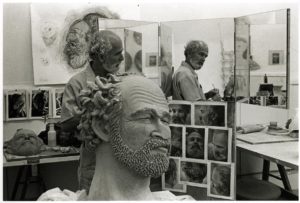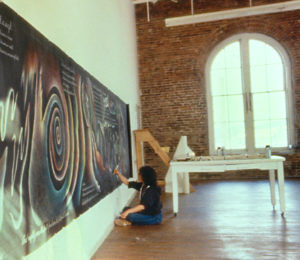
A 1978 photo of Robert Arneson in his 440 First Street studio sculpting his work “Up Against It.” (Copyright 2017 Estate of Robert Arneson)
Arts Benicia is celebrating its 30th anniversary throughout 2017. What does it take for a non-profit arts association to survive and thrive over a 30-year period? It takes commitment, the support of a community, luck, funding, and most of all, dedicated people who simply will not let it fail. Over the course of the year, we will explore all of these elements as we look at the founding of Arts Benicia, its long history, its importance to our community and the region, and most of all, the people who have been central to the organization through the years.
Part 1 can be viewed here.
Robert Arneson, Judy Chicago and other early artists
Robert Arneson’s vibrant ceramic self-portraits aside, Benicia has always been populated by colorful characters. Many have been artists, others town legends. “My friend Harlan Bailey, a wonderful poet from Martinez, has said that there is something about the Strait, this confluence of the salt water of the Bay meeting the fresh water of the Delta that makes for strange fish. I’ve told him that some of those fish are two-legged.” – Jackie DuBois, long-time Benicia resident
In the 1970s, Benicia grew as an artists’ community because artists shared their secret find with others.
“That’s how artists are,” said Kathy Erteman, an internationally known ceramic artist and former Benicia resident. “We reach out a hand and bring another artist into the fold.”
Slowly, the secret of Benicia started getting out.
Glassmakers started arriving in Benicia in the early 1970s. Stephen Smyers, who had studied art at Chico State, was the first, finding studio space at the Yuba Building in 1972 where, a few years later, he established Smyers Glass. Micheal Nourot and Ann Corcoran moved into the Yuba Building in 1974. Joe Morel followed, eventually founding Zellique Glass in 1980, also at Yuba. In 1976, David Lindsay began an apprenticeship with Nourot. Lindsay would go on to become a partner in Nourot Glass until founding his own glass studio and shop, Lindsay Glass, in 1998.
Collectively these artisans– Smyers, Morel, Nourot, Corcoran and Lindsay– elevated glass from its reputation as a craft to the fine art that it is considered today, highly prized by collectors throughout the world. They also solidified Benicia’s reputation as a center for glass art.
“The glass artists started it all. They came first” said Mike Kendall, long-time Benicia artist, “All of the rest of us really rode the coattails of the glass studios.”
One artist, paper designer Bruce Bradbury, came to town in 1976 because he heard there was a wallpaper company at the old Industrial Park. He came, interned with Wayne Carlson Wallpapers, and learned the craft of printing historic designs. With Carlson’s help, he launched Bradbury and Bradbury, a wallpaper art design company known for its historic Victorian images. Bradbury and Bradbury still operates today in the Arsenal and is known worldwide for its designs.
At the same time, Benicia was becoming home for key members of the UC Davis Dream Team. The town was close enough to Davis for an easy commute, yet far
enough away to give them the space and privacy to work. Manuel Neri, considered one of America’s most influential figurative sculptors, moved to town in 1965, buying an old wooden Gothic church which he turned into his studio and home. In this space, he created his life-sized figures in plaster, clay, marble, and bronze which defined his distinctive style.
Painter Roy de Forest had moved to nearby Port Costa. His neighbor was ceramic artist Clayton Bailey who had moved to Port Costa in 1968 where he still lives and works today. Neon artist Bill Concannon moved to Crockett, across the Strait. Funky Benicia and its neighboring towns were becoming the informal headquarters for innovative contemporary artists including the pioneers of the California Funk and Bay Area Figurative movements.
Native son Robert Arneson moved back to Benicia permanently in 1976 with his wife, Sandra Shannonhouse, and his four sons. They bought the building at 440 First St.– now the First Street Café– and converted it into studio space with a kiln out back. In 1980, they built a larger studio next door. From these Benicia locations, he created some of the most original art to be seen in America with pieces like “Klown,” “California Artist” and his controversial “Portrait of George,” a piece commissioned by the city of San Francisco to honor the assassinated mayor George Moscone.

Judy Chicago working on her 30-foot long Prismacolor pencil drawing “In the Beginning” in her Arsenal studio in the early ’80s. (Courtesy photo)
In 1979, prominent feminist artist Judy Chicago, moved to Benicia from Southern California, having heard about the town from her old friend, Manuel Neri. Her massive ceramic sculpture, “The Dinner Party,” was still on display in San Francisco. Once in Benicia, she started on another huge endeavor, “The Birth Project,” this time primarily using fabrics. She and her team worked out of an 11,000 square foot building in the Arsenal as the project grew in importance and size.
“Eventually we had more than 150 needle workers involved in the project, from all over the country, Canada and even New Zealand,” Chicago said.
Chicago also became a champion of Benicia and asked other artists to move here to work on the project including Judy Keyes who would later turn to glass art and found Smyers Glass with her husband Stephen. Benicia designer and needle worker Sally Babson lived next door to the Arnesons and, as a result, got to know Judy Chicago. She became Chicago’s technical assistant on the project.
“It was a five-year project, enormous, but that’s the way Judy thinks,” Babson said. “She was responsible for so many women coming to Benicia to help her create this project, using needlework skills that had always been called the ‘womenly arts,’ the work that women have always done.”
Arts Benicia co-founder, ceramic artist Kathy Erteman came to town in 1980 because of Keyes. The two artists met while working on Chicago’s “The Dinner Party.” Erteman stayed for 14 years.
“Benicia’s art community felt like being part of a very supporting family,” Erteman said. “I was a young artist, just starting to show my work. But everyone was so supportive. I really thrived during those years.”
Benicia had all the elements to appeal to artists: lots of inexpensive space, wonderful light, a sense of community, and a serious yet playful art vibe.
“We’re all drawn here somehow,” former Benicia resident and artist Judi Morales Gibson said. “I can’t put my thumb on it, but there is something really special about this town, a kind of magnetic force. It’s hard to say whether it is Benicia pulling in the artists or whether it is the artists who are the magnet. I do know that, there are all these layers of artists, and they pull in more. Every time I come back, a whole new layer of artists are here.”
For a closer look at the stories that make up the early years of art and artists in Benicia, go to https://artsbenicia.org/30-years-30-stories/
Up next: The Founding of Arts Benicia in 1987






Leave a Reply